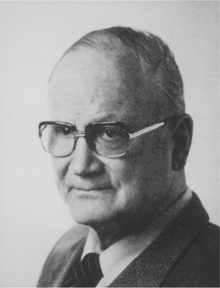Friedrich Wegener

Friedrich Wegener (April 7, 1907, Varel – July 9, 1990, Lübeck) (English: /ˈvɛɡənər/) was a German pathologist who is notable for his description of a rare disease now referred to as granulomatosis with polyangiitis. Although this disease was known before Wegener's description, from the 1950s onwards it was generally referred to as Wegener's granulomatosis.[1]
Wegener joined the Nazi Party in 1932.[1] Specifically, he was a member of the Sturmabteilung, a paramilitary branch of the Nazi party which participated in violent conflicts.[2] As a relatively high-ranking military physician, he spent some of World War II in a medical office three blocks from the Łódź Ghetto, a Jewish ghetto in Łódź, Poland.[1] He conducted autopsies on Jewish concentration camp inmates and the facility he worked in performed experiments on prisoners.[1][2] There is no direct evidence of active participation of Dr. Wegener in these human experiments, but it is likely he was aware of them.[3] The United Nations War Crimes Commission had a legal mandate against Friedrich Wegener and the Polish Institute for the Prosecution of German War Crimes confirmed that he had appeared on the central list of war criminal and security suspects.[3] Dr. Wegener was released without a trial as no charges were brought against him.[4]
The American College of Chest Physicians (ACCP) awarded Wegener a “master clinician” prize in 1989.[1] After his Nazi past was discovered in 2000, the ACCP rescinded the prize and campaigned to rename Wegener's granulomatosis to ANCA-associated granulomatous vasculitis.[1] More recently, several professional societies, including the American College of Rheumatology, the European League Against Rheumatism, and the American Society of Nephrology, proposed the name 'granulomatosis with polyangiitis' in a 2011 editorial.[3][5]
See also
References
- 1 2 3 4 5 6 Feder, Barnaby J. (2008-01-22). "A Nazi Past Casts a Pall on Name of a Disease". The New York Times.
- 1 2 Lubitz, MG (February 2018). "Granulomatosis With Polyangiitis-A Moral Impetus for Change". JAMA Otolaryngology–Head & Neck Surgery. 144 (2): 101. doi:10.1001/jamaoto.2017.2140. PMID 29121164.
- 1 2 3 Bachmeyer, C; Halioua, B (May 2013). ""Granulomatosis with polyangiitis (Wegener's)" for "Wegener granulomatosis": dermatology journals should also adopt the alternative name". JAMA Dermatology. 149 (5): 526–7. doi:10.1001/jamadermatol.2013.2060. PMID 23677076.
- ↑ Rosen, MJ (September 2007). "Dr. Friedrich Wegener, the ACCP, and History". Chest. 132 (3): 739–41. doi:10.1378/chest.07-0769. PMID 17873183.
- ↑ Falk RJ, Gross WL, Guillevin L, Hoffman GS, Jayne DR, Jennette JC, Kallenberg CG, Luqmani R, Mahr AD, Matteson EL, Merkel PA, Specks U, Watts RA (2011). "Granulomatosis with polyangiitis (Wegener's): an alternative name for Wegener's granulomatosis". Arthritis Rheum. 63 (4): 863–4. doi:10.1002/art.30286. PMID 21374588.
Further reading
- Woywodt A, Haubitz M, Haller H, Matteson EL (2006). "Wegener's granulomatosis". Lancet. 367 (9519): 1362–6. doi:10.1016/S0140-6736(06)68583-8. PMID 16631915.
- Woywodt A, Matteson EL (2006). "Wegener's granulomatosis--probing the untold past of the man behind the eponym". Rheumatology (Oxford). 45 (10): 1303–6. doi:10.1093/rheumatology/kel258. PMID 16887845.